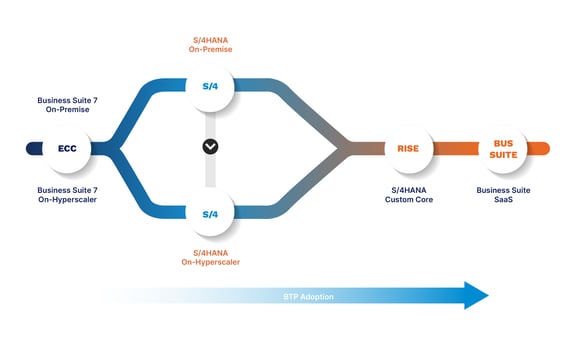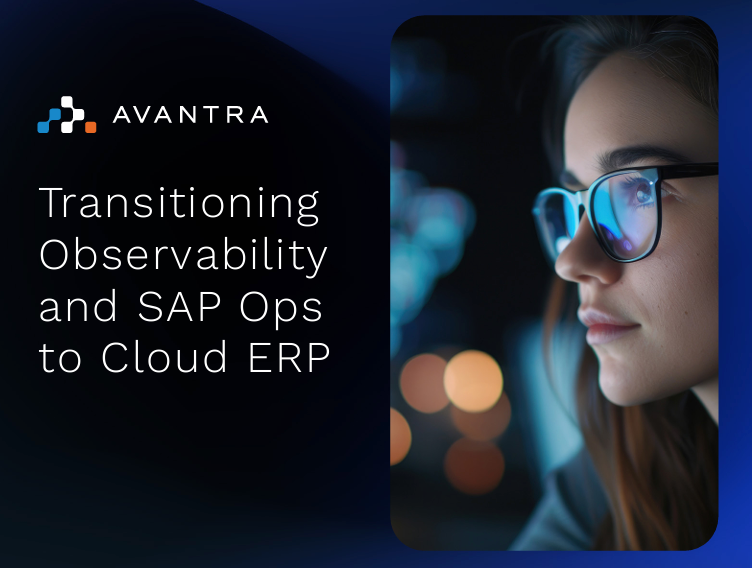5 min read
Extreme automation and the SAP Cloud ERP journey
By: Brenton O'Callaghan on May 19, 2025 11:06:56 AM

Cloud ERP arrives as the new holy grail of ERP architecture: a composable, flexible and scalable collection of core business services working together to meet enterprise ERP needs. Of course, getting there for a large enterprise with significant existing complexity across legacy SAP implementations isn’t a trivial task.
Much has been written about S/4HANA migration, but less explored are the benefits of automation solutions used for the regular operations of SAP to migration projects. These solutions offer a number of accelerators and benefits to migration projects and SAP teams, so it is worth exploring.
Drivers
A great many analysts have outlined the current market situation. To paraphrase a mix of Gartner, SAP Insider and others: most SAP ECC customers are yet to make a commitment to S/4HANA or RISE; the biggest driver for migration is the end of support from SAP; and over a third of customers consider the event an opportunity to do more than just migrate, including innovation, transformation, replatforming, and reengineering business processes or ERP systems themselves.
The challenges
The number one reported reason migration projects haven’t started is expected cost. Project length and complexity aren’t far behind and the three together tell a familiar story to SAP users: upgrades are expensive, often tricky, and take longer than expected. In fact, upgrades are difficult enough and most SAP deployments have never had one performed and are on the same version of SAP they went live with.
The challenges of upgrades and migrations are one reason many SAP users recognize the value of clean core moving forward, but many systems have decades of customizations, and greenfield migrations may be an impractical choice. And, either choice leaves customers running both legacy and destination systems for a protracted period of time – several years in most cases – and the challenges of maintaining operations across different architectures and software during the transition period.
Chunk King
One of the benefits of being an automation software firm is the exposure to so many SAP environments and especially high-volume customers, including major operators of ECC, S/4HANA and RISE in the form of Managed Service Providers. With this insight comes the benefit of watching different approaches and the challenges and outcomes common across migration projects.
A few observations:
- Nearly every SAP customer is taking a phased approach to migration. Generally, this means the major projects of moving to cloud infrastructure, migrating to S/4HANA, business transformation and cloud re-architecture are approached in chunks small enough project teams can sustain without business disruption to existing operations.
- Customers prioritize efforts differently. Some lift-and-shift first, even running ECC on RISE or hyperscalers, while others upgrade and migrate before replatforming. The facts of the existing system may drive project priorities. For example, dataset size can make upgrading and archiving before cloud replatforming more cost effective.
- The phased approach simplifies any one cycle of the total project but extends the time the enterprise remains in a transitional state, operating new and legacy systems concurrently.
- Generalizing, the longer a firm has been running SAP, the more difficult migration will be due to the amount of customization, the age and size of the existing systems, and even entrenched operational practices making change difficult.
- S/4HANA and Cloud ERP journeys often align with other business decisions and are part of a larger business transformation project.
- Migration to the cloud increases the demand for staff with SAP basis skillsets. Published SAP Customer Success Stories by Product illustrate SAP’s change in market focus. New operation tools from SAP are cloud-centric first and not designed for legacy and hybrid environments.
Make it happen
With knowledge of expected project complexity, length and resource demands, one can begin to assess where solutions often already in place today can help scale the organization to support the protracted project lifecycles typical of cloud ERP migrations. Paramount for enterprise customers is protecting the existing business and operations. Ensuring SAP teams are productive and not firefighting day-to-day issues creates opportunities for project work and innovation.

Automation for SAP Operations is an essential partner, managing the daily monotony of SAP activities including change, monitoring, and common infrastructure management tasks such as system refresh. With large scale projects, SAP teams are facing regular operations in addition to specialty tasks including provisioning project landscapes, updating test data in QA systems, and managing the migration of change between multiple landscapes.
Supporting hybrid environments and operations using different tooling for each environment creates significant challenges for operational efficiency. Many customers face a complex mix of platforms during their Cloud ERP journey. Most large enterprises have multiple landscapes, and not every existing ECC or S/4HANA system will move at once. Some migrations will make more sense as new deployments in platforms such as BTP, while others – business warehouse, for example – may not make sense to migrate ever and will ultimately face decommissioning when a suitable replacement is operational.
A key observation across dozens of projects and customers is teams using a single pane-of-glass for SAP operations have better project outcomes. In practice, this means managing SAP operations across on-premise, hybrid and new Cloud ERP architectures at the same time with a single operations solution. The single point of visibility and automation reduces outages in production and project landscapes and accelerates cycle times by automating landscape management tasks. And, they are prepared for go-live as soon as the project phase completes.
Take away
SAP migration projects can be expensive, time consuming and complex. Observation of numerous migration projects with many unique requirements has resulted in a few key conclusions consistent with most projects:
- SAP Ops automation reduces the demand on SAP basis teams and helps mitigate the additional tasks and requests placed on them during migration projects.
- Consistent, single-pane-of-glass observability across legacy and future ERP environments reduces outages and technical failures and accelerates resolutions.
- Reducing fire-fighting and emergencies leaves more time for innovation and project work.
- Implementing automation as part of the migration project provides advantages at go-live.
For more information on SAP Ops and solutions for managing a complex mix of on-prem, hybrid and Cloud ERP, speak with one of our experts to find out how Avantra can transform your SAP operations and Cloud ERP projects.
Related Posts
Tackling the challenges of SAP's hybrid ERP world
SAP Hybrid ERP Infrastructure presents an opportunity and a challenge at the same time. The Q2...
SAP HANA Migration | Avantra
As a revolutionary column-based in-memory database, SAP HANA has been praised as one of the most...
Future-Proofing Your Business: Why RISE with SAP is More Than a Technical Upgrade
2025 and 2027 are well documented dates in SAP circles. Many SAP users have viewed the transition...




